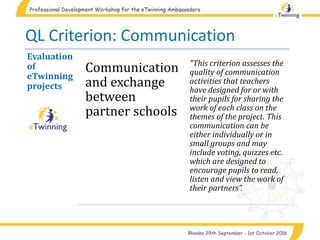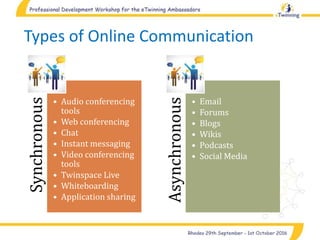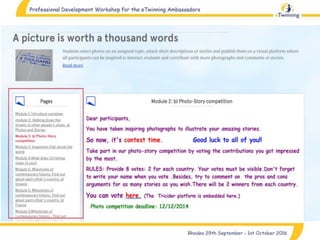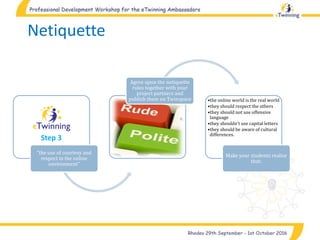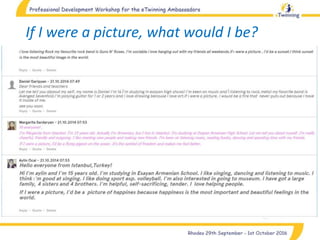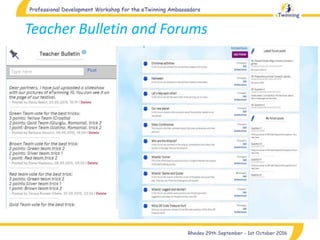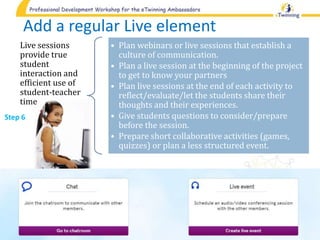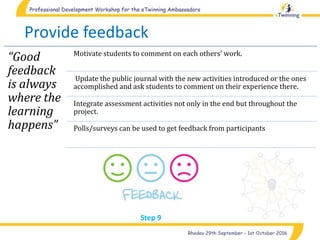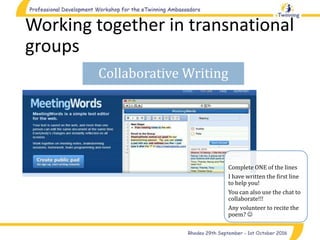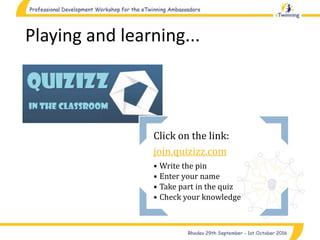Communication and collaboration in eTwinning
- 1. Communication and Collaboration in eTwinning Paraskevi Belogia GR NSS
- 2. What makes an eTwinning project successful?Follow the link and write shortly What is the key to a successful eTwinning project. (5 minutes) http://www.tricider.com/brainst orming/2mKA78xNDjB (Group 1) http://www.tricider.com/brainst orming/2k2NKOYexLB (Group 2)
- 3. QL criterion: Collaboration between partner schools Evaluation of eTwinning projects Collaborative activities go beyond communication: the partners are not just recipients of information; they are team-members, co-authors and co-creators. Collaboration means that both classes need the contribution of their partner class to complete the activity. Working in mixed-nationality groups is a very effective practice for collaborative work. (small group from one class + small group from another class = mixed- nationality group)
- 4. QL Criterion: Communication Evaluation of eTwinning projects Communication and exchange between partner schools "This criterion assesses the quality of communication activities that teachers have designed for or with their pupils for sharing the work of each class on the themes of the project. This communication can be either individually or in small groups and may include voting, quizzes etc. which are designed to encourage pupils to read, listen and view the work of their partners”.
- 5. Types of Online CommunicationSynchronous • Audio conferencing tools • Web conferencing • Chat • Instant messaging • Video conferencing tools • Twinspace Live • Whiteboarding • Application sharing Asynchronous • Email • Forums • Blogs • Wikis • Podcasts • Social Media
- 6. Preparatory stage “Successful communication and collaboration are achieved when students are comfortable with technology” • Assess your students' skills on ICT tools • Provide short training courses or tutorials on how to use technology. • Prepare a detailed time schedule and ask students to keep to the deadlines. • Plan your Twinspace carefully. Step 1
- 9. • update their Twinspace profiles • start interacting with their partners • leave short messages on their partner's walls • log in regularly Ask your students to: Create Twinspace accounts for your students Step 2
- 11. Netiquette "the use of courtesy and respect in the online environment" Agree upon the netiquette rules together with your project partners and publish them on Twinspace •the online world is the real world •they should respect the others •they should not use offensive language •they shouldn't use capital letters •they should be aware of cultural differences. Make your students realise that: Step 3
- 12. Break the Ice Plan team building activities where students will: get to know each other learn to work together support each other build strong relationships. Step 4
- 13. Who am I? Nice to meet you! My name is Raphaila. I'm 12 years old. I'm from Larissa, Greece. I'm well built and I'm tall. My face is oval and I have fair hair. I've got brown oval eyes and I'm pretty. I'm clever and hard working, but I'm a bit talkative, too. When I grow up I would like to be a singer, an actress and a vet.I love reading, playing the piano and playing with my friends!
- 15. Draw my portrait! My name is Romana Králiková. I’m 11 years old. I live in Poland.My birthday is on August 14th 2000. My favorite subjects are Chemistry and English language. I’ve got long brown hair. I’m thin and tall. I have got green eyes. My favorite hobbies are gymnastics, cycling, swimming, athletics, reading
- 16. If I were a picture, what would I be?
- 17. Use the Twinspace Communication Tools Encourage partners to use the Twinspace tools to communicate with each other. Twinmail: use the mailbox to send students important information (reminders, clarifications, deadlines) encourage them to use the mailbox to communicate with their peers Teacher Bulletin: use it to contact project partners (visible only to teacher partners) Discussion Forums: initiate discussions and motivate students to take part. Be mindful of student differences (geographic, cultural and look for similarities to find connections (shared interests) Step 5
- 18. Teacher Bulletin and Forums
- 19. Add a regular Live element Live sessions provide true student interaction and efficient use of student-teacher time • Plan webinars or live sessions that establish a culture of communication. • Plan a live session at the beginning of the project to get to know your partners • Plan live sessions at the end of each activity to reflect/evaluate/let the students share their thoughts and their experiences. • Give students questions to consider/prepare before the session. • Prepare short collaborative activities (games, quizzes) or plan a less structured event. Step 6
- 20. Integrate collaborative activities into your eTwinning projects Team your students up in transnational groups Assign roles for each member of the group or team students up according to their interests/talents. Assign the role of team leader or pupil administrator to some of your students. Step 7
- 21. Engage students in active learning Students should be engaged in activities where they: • Find and evaluate information • Connect and collaborate • Produce and share original content • Plan fun, creative activities that offer self-expression Step 8
- 23. A school over the Rainbow
- 24. "A picture is worth a thousand words" Students walk down the streets of their hometowns, spot different types of people and take photos. They write imaginary stories about the person/people depicted in their picture. The stories should somehow reveal aspects of everyday life, culture and lifestyle of participants' hometowns. It is advisable to narrate their stories in 3rd person.
- 25. Provide feedback “Good feedback is always where the learning happens” Motivate students to comment on each others’ work. Update the public journal with the new activities introduced or the ones accomplished and ask students to comment on their experience there. Integrate assessment activities not only in the end but throughout the project. Polls/surveys can be used to get feedback from participants Step 9
- 26. Forms of feedback Individual feedback (teacher- expert - self ) Group feedback Peer feedback
- 27. Use the right ICT tools Web 2.0 technologies are fundamentally reshaping and realigning many aspects of the communication loop: the people with whom teachers, students, and parents communicate how they communicate what they communicate about and where and when they communicate Step 10
- 28. from theory to practice! Follow the link and take a look at the tasks I have prepared for you: http://bit.ly/2d984eI
- 29. Finding each other... Create your collaborative interactive map! Click on the link and create your avatar!: https://mybluerobot.com/c reate-your-own-avatar/ Click on the link: http://j.mp/2dh2TfY Click on Additions- Add marker simple-,add your name and your place, a short description of yourself, add your avatar and pin yourself on the map!
- 30. Get to know your group... Use the dotstorming tool and find five things you have in common. Add as many ideas as you like but the ones you will present in the end as a group should have been voted by all the members of the group. Use the chatroom to communicate with the rest of the group members.(10 min.)
- 31. Creating a collaborative drawing Drawing together with our partners! Use the FlockDraw tool and Create a logo for our workshop (Communication and Collaboration in eTwinning) “(5 min.)
- 32. Working together in transnational groups Complete ONE of the lines I have written the first line to help you! You can also use the chat to collaborate!!! Any volunteer to recite the poem? Collaborative Writing
- 33. Self-evaluation checklist •Work in pairs to add more questions to the google doc •What should you have done while planning the project? •What should you have done to succeed in working collaboratively and communicating successfully with your partners? Self-evaluating our eTwinning projects
- 34. Playing and learning... Click on the link: join.quizizz.com • Write the pin • Enter your name • Take part in the quiz • Check your knowledge
- 35. Evaluating-Giving Feedback... Click on the link: https://todaysmeet.com/PDWRhodes Write your name/nickname and leave your comments on the workshop. Did you like it? Did you find it useful?
- 36. Feel free to adapt and use the presentation for your own workshops pbelogia@hotmail.com



